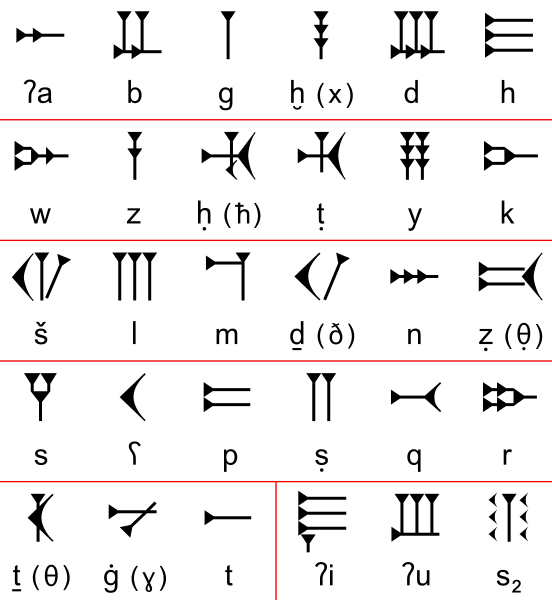Berkas:Ugaritic-alphabet-chart.svg

Ukuran pratayang PNG ini dari berkas SVG ini: 552 × 600 piksel Resolusi lainnya: 221 × 240 piksel | 442 × 480 piksel | 707 × 768 piksel | 942 × 1.024 piksel | 1.884 × 2.048 piksel | 622 × 676 piksel.
Ukuran asli (Berkas SVG, secara nominal 622 × 676 piksel, besar berkas: 28 KB)
Riwayat berkas
Klik pada tanggal/waktu untuk melihat berkas ini pada saat tersebut.
| Tanggal/Waktu | Miniatur | Dimensi | Pengguna | Komentar | |
|---|---|---|---|---|---|
| terkini | 13 Maret 2012 14.23 |  | 622 × 676 (28 KB) | AnonMoos | tweaking crossbar of ħ |
| 9 Maret 2012 01.13 |  | 622 × 676 (28 KB) | AnonMoos | Table of letters of the Ugaritic cuneiform alphabet, with a conventional transcription. Where the "Semitological" symbols are somewhat divergent from the IPA symbol for the letter's probable pronunciation, the I... |
Penggunaan berkas
Halaman berikut menggunakan berkas ini:
Penggunaan berkas global
Wiki lain berikut menggunakan berkas ini:
- Penggunaan pada af.wikipedia.org
- Penggunaan pada am.wikipedia.org
- Penggunaan pada ar.wikipedia.org
- Penggunaan pada ast.wikipedia.org
- Penggunaan pada be.wikipedia.org
- Penggunaan pada bg.wikipedia.org
- Penggunaan pada ca.wikipedia.org
- Penggunaan pada de.wikipedia.org
- Penggunaan pada el.wikipedia.org
- Penggunaan pada en.wikipedia.org
- Penggunaan pada en.wiktionary.org
- Penggunaan pada eo.wikipedia.org
- Penggunaan pada es.wikipedia.org
- Penggunaan pada fa.wikipedia.org
- Penggunaan pada fr.wikipedia.org
- Penggunaan pada gl.wikipedia.org
- Penggunaan pada got.wikipedia.org
- Penggunaan pada he.wikipedia.org
- Penggunaan pada it.wikipedia.org
- Penggunaan pada ja.wikipedia.org
- Penggunaan pada kk.wikipedia.org
- Penggunaan pada ko.wikipedia.org
- Penggunaan pada lfn.wikipedia.org
- Penggunaan pada ml.wikipedia.org
- Penggunaan pada nl.wikipedia.org
- Penggunaan pada no.wikipedia.org
- Penggunaan pada pl.wikipedia.org
- Penggunaan pada ru.wikipedia.org
- Penggunaan pada rw.wikipedia.org
- Penggunaan pada sl.wikipedia.org
- Penggunaan pada sr.wikipedia.org
- Penggunaan pada sv.wikipedia.org
- Penggunaan pada th.wikipedia.org
- Penggunaan pada uk.wikipedia.org
- Penggunaan pada uz.wikipedia.org
- Penggunaan pada zh.wikipedia.org
